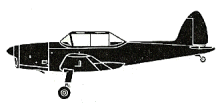
ASN Wikibase Occurrence # 155668
This information is added by users of ASN. Neither ASN nor the Flight Safety Foundation are responsible for the completeness or correctness of this information.
If you feel this information is incomplete or incorrect, you can submit corrected information.
| Date: | Friday 1 April 1955 |
| Time: | 11:30 LT |
| Type: |  de Havilland Canada DHC-1 Chipmunk T Mk 10 |
| Owner/operator: | Durham UAS RAF |
| Registration: | WP780 |
| MSN: | C1-0670 |
| Fatalities: | Fatalities: 0 / Occupants: 2 |
| Other fatalities: | 6 |
| Aircraft damage: | Destroyed |
| Location: | Otterburn Ranges, 6 miles north of Otterburn, Northumberland -
 United Kingdom United Kingdom
|
| Phase: | Manoeuvring (airshow, firefighting, ag.ops.) |
| Nature: | Military |
| Departure airport: | RAF Usworth, County, Durham |
| Confidence Rating: |
Written off 1 April 1955: Chipmunk T10 WP780 crashed onto the Otterburn Ranges, 6 miles north of Otterburn, Northumberland, killing six people on the ground.
The Durham University Air Squadron (UAS) Easter camp was to be held at RAF Usworth starting from 18th March 1955. The camp was to be divided into three periods, the last of which running from 1st April 1955 until 7th April 1955 when the camp officially closed.
As part of the Easter camp a detachment of Durham UAS Chipmunks were to operate from Usworth near Sunderland and take part in an Army Co-Operation exercise over the Otterburn Range with Cadets of the Women’s Royal Army Corps (WRAC) under supervision of the regular Army.
Chipmunk WP780 was one of three taking part in the exercise and it left Usworth with two other aircraft at 10:30 hrs with the pilot Flt Lt Richard Vere Potts at the controls, and Cadet Pilot Michael Hanson acting as the observer. Richard Potts was a WWII veteran having served with various squadrons during the war. Whilst serving with 229 Squadron based in Malta, he damaged a Junkers Ju88 on 4th April 1942.
The purpose of the flight was to locate a group of Army personnel who were operating around Linshiels Lake and to carry out a mock attack on them by dropping "bombs" (in the form of toilet rolls!), which also acted as markers. The flight were unable to find the Army personnel near the lake so they decided to drop their ‘bombs’ onto the observation post situated on top of a cliff where around 19 cadets from the WRAC, and around the same number of cadets from the Royal Electrical and Mechanical Engineers were sitting on the ground watching the exercise.
The aircraft was one of a formation of three making low level runs over spectators at an observation post. During one pass, the aircraft made a turn to port at very low level and the wing tip struck some of the spectators. The aircraft then struck the ground and cartwheeled down a hill. The injured were the aircraft's two crew; Flight Lieutenant Richard Potts and Officer Cadet Michael Hanson; as well as Corporal George Imrie, Officer Cadet Heather Maxwell, Officer Cadet Yvonne Horsburgh, Sergeant Dorothy Boyland, Corporal Leonard Arrowsmith and Quartermaster Sergeant Thomas Course.
Those killed were:
Sergeant Ewart Anthony Austin, aged 26 (Service Number 19174326, Royal Artillery Permanent Staff Instructor, Durham University)
Officer Cadet Margaret Nora Holwell, aged 19 (Service Number W391009, Durham University Officer Training Corps)
Officer Cadet Margaret Elizabeth Gardner, aged 20 (Service Number W390844)
Officer Cadet Alan Terence Holmes, aged 21 (Service Number 22778416)
Officer Cadet Keith Forrester Steadman, aged 21 (Service Number 23216233)
Officer Cadet Pauline Therese McHaffie, aged 19 (Service Number W391619)
NOTE: Some sources give an incorrect date of "31/03/1955" as the date of the crash. The date of 01/04/1955 is correct - the accident was reported in the newspapers on 02/04/1955 (see links below)
Sources:
1. Halley, James (1999) Broken Wings – Post-War Royal Air Force Accidents Tunbridge Wells: Air-Britain (Historians) Ltd. p.169 ISBN 0-85130-290-4.
2. Royal Air Force Aircraft WA100-WZ999 (James J Halley, Air Britain, 1985 p.83)
3. Category Five; A Catalogue of RAF Aircraft Losses 1954 to 2009 by Colin Cummings p.125
4. https://acia.co.uk/1955/04/01/chipmunk-wp780/
5. http://www.ukserials.com/results.php?serial=WP
6. https://forum.keypublishing.com/showthread.php?100658-1955-aviation-incident-(Revived-thread-new-info)_
7. http://www.nelsam.org.uk/NEAR/Losses/Losses-PostWWII.htm
8. Schenectady Gazette - April 2, 1955: https://news.google.com/newspapers?nid=1917&dat=19550402&id=4QIuAAAAIBAJ&sjid=gYAFAAAAIBAJ&pg=4650,234886&hl=en
9. http://www.rafcommands.com/forum/showthread.php?6333-Flt-Lt-Richard-Vere-Potts-(128004)/page2
Revision history:
| Date/time | Contributor | Updates |
|---|---|---|
| 30-Apr-2013 01:54 | Dr. John Smith | Added |
| 30-Apr-2013 02:02 | Dr. John Smith | Updated [Operator, Source, Narrative] |
| 29-Nov-2019 22:24 | Nepa | Updated [Operator, Operator] |
| 10-May-2020 00:36 | Dr. John Smith | Updated [Time, Operator, Location, Departure airport, Source, Narrative] |
| 10-May-2020 09:38 | MIG29 | Updated [Aircraft type, Operator, Location, Departure airport, Operator] |
Corrections or additions? ... Edit this accident description
The Aviation Safety Network is an exclusive service provided by:


 ©2024 Flight Safety Foundation
©2024 Flight Safety Foundation